Donkey Kong Country Tropical Freeze Full E3 Interview
The folks from Nintendo and Retro Studios share the details on the Kong family's first high-definition adventure.
This article first appeared on USgamer, a partner publication of VG247. Some content, such as this article, has been migrated to VG247 for posterity after USgamer's closure - but it has not been edited or further vetted by the VG247 team.
This year at E3, we met with Donkey Kong Country Tropical Freeze producer Kensuke Tanabe, director Risa Tabata, and Retro Studios' Michael Kelbaugh shortly after the announcement of the game to discuss their unexpected Donkey Kong sequel. Among our topics: Its secret Super Mario Bros. 2 connection, Shigeru Miyamoto's ever-present influence, and love for Stanley the Bugman.
USgamer: What's different about this game, as far as differences over the original and of course over the Super NES games?
Kensuke Tanabe: As you heard in our software showcase explanation earlier, one thing we’re doing is camera work. Compared to the traditional side-scrolling camera, we’re using what we call a rotating camera, which allows you to see things from different angles. Having the rotating camera itself isn’t anything rare or unusual, but how it impacts gameplay I think really is for us. If you’ve played the demo, you’ve seen what I’m talking about.
USG: Yeah. I’ve seen the rotating camera style done in two- or two-and-a-half-dimensional platformers since the PlayStation days, with games like Klonoa. But I’m curious about, as developers – how have you felt this impacting your approach to the level design and the things you put into the game?
Risa Tabata: One thing we found that’s bringing something completely different, although it may sound very simple… For example, if you’re going along side-scrolling, you’ve got the camera here, and you’re aiming at something, all you have is this axis. You’re just aiming up or down. If you bring the camera back here, now you have the ability to hit targets moving left or right as well as up or down. The vertical and horizontal axes come into play. That’s something that, again, impacts everything in gameplay.
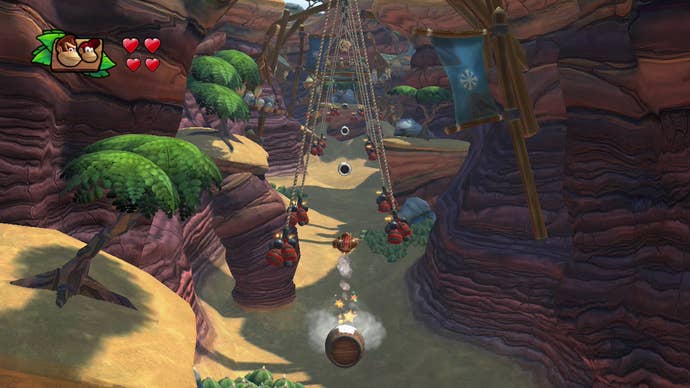
Michael Kelbaugh: We also had to fill more space with more stuff. Instead of just side-scrolling and shooting in the background and foreground, there are also elements in between them. From a level layout standpoint, it’s allowed us to introduce more elements and use that space. It’s not just background and foreground gameplay. We also take advantage of the real estate between them. It’s a bigger experience. We have more stuff to incorporate into it.
USG: Have you made any significant changes to the basic mechanics of the game? Are there things that you haven’t mentioned in the demo that you’re adding to help differentiate the core play from Donkey Kong Country Returns, or have you stuck to that as the baseline?
KT: The basic core mechanics are pretty similar, I think. One thing that we’ve done that I think you’ll find interesting, though it’s not available on the show floor here, is that we’ve added Dixie as one of the buddy characters. Previously, you know, you could jump here, but if you have Dixie as your buddy and you jump, you’ll be able to elevate a bit in mid-jump. I think just even adding that, as you’re moving through obstacles and jumping from platform to platform and navigating your way through the field, you’re going to see that just the addition of Dixie and that mid-jump elevation change brings a huge change to the gameplay. We also have the plucking.
?MK: I like plucking, because it’s kind of an old-school feature that Tanabe worked on with Super Mario Bros. 2. When he said, "You know, it would be cool to put that into Freeze," I thought it would be a great kind of legacy feature that we’d love to bring back. I was really happy to see that.
USG: Yeah. Not to get too off-topic, but this kind of feels like a Super Mario Bros. 2 revival this week. Between this and 3D World, which incorporates the multiple characters with different powers. How involved have you been with that other game? Have you mostly just focused on Donkey Kong?
KT: Yeah, I’m just on Donkey Kong. Donkey Kong, Donkey Kong, Donkey Kong.
MK: I was going to say, how do you find time?
?USG: So when you found out about Super Mario 3D World, it was a surprise?
All: Yes!
KT: One thing that’s interesting is that a lot of the guys who are working on Super Mario 3D World are guys who played Super Mario Bros. 2. I feel almost like a father, like my kids are working on these other games now. They played what I made.
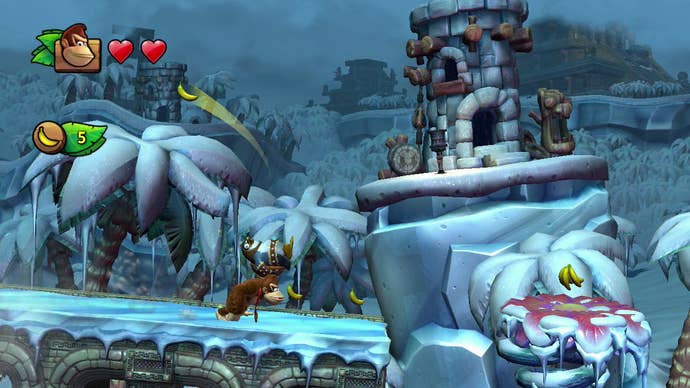
USG: Speaking of legacy, how much involvement have you had with the previous Donkey Kong games, each of you?
?MK: Well, I’ve been with Nintendo for 25 years. I worked on DKC, DKC2, DKC3, DK Land… I worked on every DK title. But by "worked on," I mean that I did a lot of different things. I managed the testing department, the localization department, the evaluation department. Compared to the development side, I was more on the support side for those. I’ve been involved in development for many DK titles at different levels. Working on it here at Retro has been very…sentimental for me. Especially working on it with Tanabe-san and Risa-san, because Tanabe-san worked on it… Not to this degree, but back in the '80s and '90s, we worked together on it as well. Being able to bring it back to Retro and work on it again was a real special experience.
?KT: For me, my first experience was working on localization of English to Japanese on the Rare titles. I actually went to Rare’s studio and worked there. One thing that surprised me is that their studio is basically a set of refurbished, reconstructed stables. They’re barns. I was thinking, "Out here, this is where they’re making all these games?" I was a little surprised.
MK: Their address was 20 Manor Farmhouse, Twycross, England. It was an old farmhouse. They’d turned the stables into workstations. The covenant wouldn’t allow them to build a new building, so they had to refurbish old buildings into work spaces.
KT: From that to now, I’ve worked directly on Donkey Kong Country, the revival of it. 15 years later, it’s an interesting feeling. It’s a little like coming home.
RT: For myself, when the Super NES game came out, I was just a kid. My first development relationship with Donkey Kong comes from Donkey Kong Country Returns on the Wii. It felt super fresh and new. It was great.
?MK: When people say, "How come Donkey Kong Country Returns is so difficult," to me, I think, "You’re crazy." You forget what the original Donkey Kong Country was like. It was a hard game. To us, we want to stay true to the franchise. The people that say, "This is really hard, this is really hard," they need to go back and play the original Donkey Kong Country, because the similarities as far as difficulty level is concerned are very close.
USG: You’ve talked a lot about the Donkey Kong Country games, but have any of you worked on any other Donkey Kong games, besides Donkey Kong Country?
KT: I was the producer on Mario Vs. Donkey Kong, the Nintendo Software Technology game.
RT: No, not me.
MK: I worked on Donkey Kong 64, but again, in a support role. I worked on localization. Donkey Kong Land, that whole game. But I think that’s about it.
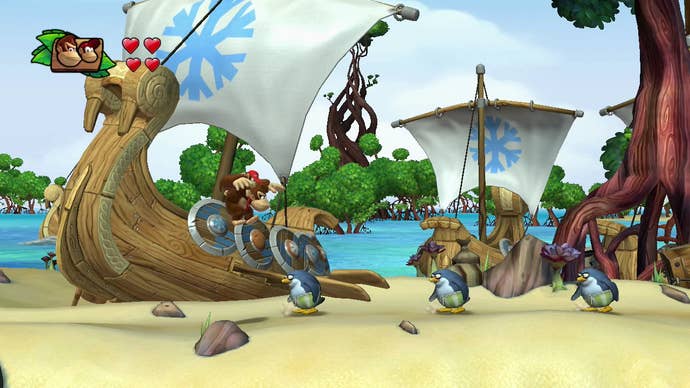
USG: That’s interesting, because one of the things that really caught my eye about the first Donkey Kong Country Returns is that it seemed to incorporate elements of some of the other Donkey Kong games, like Jungle Beat. You’d waggle and pound things and beat things up like in Jungle Beat. Grabbing onto grass and that sort of thing reminded me a bit of King of Swing, too. I don’t know if those were conscious efforts to incorporate some of those other Donkey Kong ideas, or if they just evolved naturally from the design of the game.
KT: It’s interesting, because in Jungle Beat – actually, the Super Mario 3D World team is the team that made Jungle Beat. At that point, they all thought the motion, especially for things in Donkey Kong like the ground-pounding, was great. I remember Mr. Miyamoto saying, "Hey, this really works well with Donkey Kong."
?MK: Do you remember the dun-dun-dun-dun, and then the DA-DOOM DA-DOOM DA-DOOM!
RT: Yeah! [laughter]
?MK: When we were looking into the ground pound, I won’t say we "mimicked," but we looked at the whole Jungle Beat setup one for one, basically. We worked that in just as a prototype and we showed it to Miyamoto. He was going boom-boom-boom, and then boom-boom-boom. He says, "No, I don’t want boom-boom, boom. I want ba-BOOM ba-BOOM ba-BOOM!" It wasn’t literal, right? It wasn’t one motion translating to one motion. It was one motion leading to that ba-BOOM ba-BOOM ba-BOOM. So we said, "Sure, we can do that." It worked out much better. It was much more fluid, more ape-like almost. It was more fun.
USG: It’s interesting to hear about Mr. Miyamoto’s involvement in the Returns games, because of course he's the father of Donkey Kong. I guess I didn’t realize that he’s still involved in the series to some degree. Has he given any other advice or thought on, "This is Donkey Kong, this isn’t Donkey Kong?"
RT: Well, not so much this time around. That story was from the making of Donkey Kong Country Returns on the Wii. I wonder if you remember, from that game, where Donkey Kong takes a deep breath and blows? That’s Mr. Miyamoto. That came from him.
MK: When we first started… He didn’t just give it to us. We had to earn it, right? We had to put together demos. We had to prove ourselves worthy of the Donkey Kong franchise. I remember him saying, "This is my baby. You’d better get it right." This was before we started the demo. He was exceptionally passionate about Donkey Kong. Along the way, he’d give us tips and a little bit of advice. It was all about being able to prove whether or not Retro could handle continuing his vision.
USG: I’ve actually been playing the older arcade Donkey Kong games lately, just to go back to the roots of platform gaming and get a feel for that. Something that I find interesting about the Donkey Kong series is that it’s so mutable. There are so many different interpretations of it. Even if you look at the first three games, you have a platformer, and then you have a game about crawling vines, and then you have a shooter. There’s this incredible variety within the series. And then, on the other hand, you have the Donkey Kong Country games, which are very consistent, reliable platformers. How do you incorporate some of that legacy of unpredictability and dynamism into something that is kind of running off a set template?
MK: [to Tanabe] I’m glad you’re answering that. [laughter]
KT: Mario is like… Let’s give Mario as an example of something that’s very clear and defined. If you look at Mario here, you have a very clear distinction between 2D games and 3D games. The 2D side-scrollers are continuing in the New Super Mario series, and then you have games like Mario 64. You have Sunshine and Galaxy and Galaxy 2 and now 3D World. Those are the 3D world Marios, and then you have the 2D world Marios. There’s a very clear line between those two series.
Now, with Donkey Kong, it’s never been that clear throughout time. We went from 2D to 3D on the Nintendo 64 and the GameCube, and then back to 2D here. We had things like Jungle Beat, these experimental sorts of projects. Here, we said, "Let’s go back to 2D. Let’s try 2D," and set to reinventing the Donkey Kong Country franchise. In the end, it’s not like we’ve ever drawn a clear distinction between two types of games. We’re really looking at, "Hey, what do we have with our hardware? What does the marketplace want?" We’re adaptable. We can respond to those needs. We’ll come up with games that might incorporate elements from both sides.
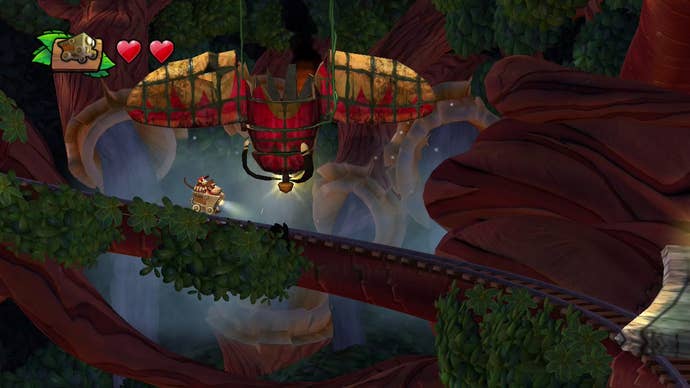
USG: If we could talk a little bit more about the new game, Tropical Freeze, you mentioned that Dixie Kong is in the game, but she’s not playable on the floor. I’m curious to hear a little more about her mechanics. For instance, if you’re playing two-player, does she still give you that double-jump ability, or is that something that’s only available when she’s riding on Donkey Kong?
?RT: First of all, as far as the single-player goes, as you mentioned earlier, you have Donkey Kong and then you have his buddy character. We have Diddy here, but we’ve also added Dixie as a partner character. In the multiplayer, player one is Donkey Kong and player two will be able to select between either Dixie or Diddy. Dixie, as far as her characteristics or features, they’re pretty much the same whether it’s single-player or multiplayer.
In either case, when her ponytail whips around, she’s going to give that extra lift. You’re still going to be able to have Dixie up here, riding on Donkey Kong’s back. Players are going to be able to choose – since she has the ability for that second jump and that hover, when you’re going through an obstacle, you may want to say, "Hey, we need to get through this. Let’s team these guys up and go together." They can go separately as well, but that ability lends itself well to the levels that we’ve put together.
?KT: We’re thinking that we’ll probably add one more character. So we’ll invite you to go ahead and take your best guess as to which Kong you think is going to join us.
MK: Which one would you want?
USG: Hmm. I remember… what was his name? Kiddy Kong, the baby one, in the third game? Whatever his name was.
Translator: There was Funky, Lanky, Candy… We’re going to find out. We’re Nintendo and we don’t know this? What the heck is wrong with us? Jeremy, you’re a game journalist, what’s going on.
USG: No, I forgot to do my research this morning. [laughs]
KT: Well, since we can’t think of the name, you know it’s not that one. [more laughs]
MK: Or we’re hiding it very well.
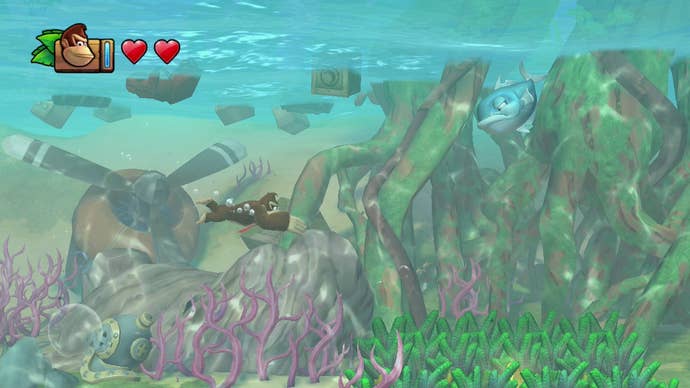
USG: If I had my choice of a Donkey Kong character to have as the third partner character, I’d say Stanley the Bugman, from Donkey Kong 3. The guy with the DDT gun.
[Lots of knowing "Ehhhh"s]
KT: We’ll have to think about that.
MK: It sounds like he deserves his own game.
?USG: Are you able to say at all who the third character is now, or is that still a secret?
KT: No, we’ll have to wait on that a bit.
USG: In the single-player game, are you able to choose at the beginning of a stage or at the beginning of the game which partner character you take? Or is that level-dependent?
?RT: No, you don’t choose. You’ll be going through a level and when you run across a barrel, whoever pops out is who you’ll have as your buddy character.
?USG: But you said that in multiplayer, you get to choose which character you want.
RT: Right.
USG: So does Dixie have any particular weaknesses or downsides? It sounds like her ponytail double jump is pretty good.
KT: Well, her plucking strength is weaker. That takes her longer. Also, if she’s carrying an object or an enemy, she moves slower. If you’ve played Super Mario Bros. 2, again, you can probably guess how it works.
USG: It’s great that you’re able to call back to a game from 25 years ago and say, "Hey, that works here too."
MK: Yeah. That’s what’s great about Nintendo. We have that legacy. We have people that have been working on the same franchises for 40 years.
USG: What do you hope to accomplish with this game and with the series? What experience do you hope to provide that people have never seen before?
RT: For myself, I knew that Retro was working on the rotating camera, but the first time I saw it, I believed it was on a micro-stage. I knew that the camera was implemented, but the first time I was able to experience it for myself, I actually went, "Whoa!" I was a little surprised. This is hypothetical, because I don’t remember exactly, but if picture looking at a roller coaster, if you watch a roller coaster from the side doing this, you’re going to get a completely different experience when all of a sudden you’re looking at the roller coaster this way and doing this. The difference that illustrates is one of the differences we’re bringing to the game with the camera.
KT: As I think you know, this series is known as a difficult series. For the fans of the series, I don’t want to betray that expectation of a real challenge. But of course, I want to make the game as accessible as I can to casual players, people who haven’t had an opportunity to try the series yet.
So one of the things that we’ve done is, we’ve taken a feature from the 3DS version of Donkey Kong Country Returns, which is the green balloon. We brought it back in this version. It basically allows the player, as you know, to fall to what is normally a loss of life. The green balloon lifts them up and they can place themselves where they want and let go. It gives the power to use or not use it to the player, though. Basically, we’re just providing a system for players who want to use it if they want to. They can go purchase this item in-game and use it, but of course they don’t have to. It’s just giving those people a chance to get into the game a little easier and make it more accessible. You have the standard Donkey Kong challenge for our veteran players who are really into it, and we’ve got some aids that are available for people who maybe aren’t as used to the series that will allow them to have some of the same experiences as other players.
?MK: I think as well, just due to the capabilities of the Wii U… It’s quite a powerhouse. We’ve been able to do a lot of great stuff that we hadn’t been able to do before. A lot of translucency in the ice. The water is just phenomenal. A lot of the shading technology that’s new to the Wii U, a lot of the lighting. It’s quite a box. We’ve been able to bring some really nice visuals to it that we couldn’t before. I think people will really like seeing it in HD.
RT: Underwater is fantastic. You saw that Donkey Kong does the breaststroke? Retro was very picky about getting that animation just right. Not only does it feel very natural, it feels really good to be in the water. You get that sense of resistance from the water. It feels like you’re swimming. It looks great, but you also get that resistance. It’s a good feel. That’s something we didn’t have in the old Super NES games.
